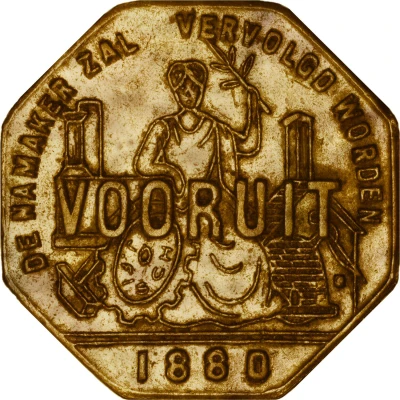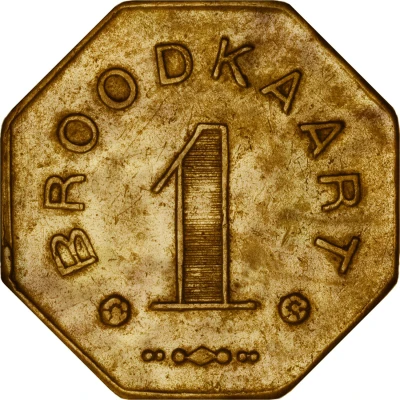


1 Broodkaart - Vooruit A. Fisch
1880 year| Brass | 3.14 g | 23 mm |
| Location | Belgium |
|---|---|
| Type | Trade tokens › Co-operative tokens |
| Year | 1880 |
| Composition | Brass |
| Weight | 3.14 g |
| Diameter | 23 mm |
| Thickness | 1.1 mm |
| Shape | Octagonal (8-sided) |
| Technique | Milled |
| Orientation | Medal alignment ↑↑ |
| Demonetized | 1 July 1966 |
| Updated | 2024-11-13 |
| Numista | N#52029 |
|---|---|
| Rarity index | 62% |
Reverse
A large "1" in the center, over an ornamented line,
The word "BROODKAART" written in a circle, with a five-petalled flower before and after the word.
Script: Latin
Lettering:
BROODKAART
1
Translation: BREAD CARD (TOKEN)
Engraver: Antoine Fisch
Edge
Plain
Comment
This token is a bread card (a card for obtaining food) of the socialist consumer organization Vooruit (1880-1970), which was founded first as a cooperative bakery Vooruit to protect workers against the instability of capitalism.
The year on the token is 1880 - the year of foundation of the Vooruit in Ghent (Belgium), later editions were always issued with the year 1880.
There are different varieties of the obverse (A.FISCH or J. FISCH in the comb wheel, and with or without dot after "WORDEN" - the variety with the dot also has an extended right leg in the A in ZAL). Also, there are different varieties of all tokens.
The tokens by Antoine Fisch were issued from 1880 to 1892. In 1892, his son Joseph took over and continued the production under his name.
The tokens by A. Fisch are known as #1 (which has an extended right leg of the A in ZAL, with variants 1A, 1B, 1C and 1D) and #2 (which has a normal letter A in ZAL, with variants 2A, 2B, 2Ca and 2Cb) in the catalog “Het Huisgeld van de Gentse S.M. VOORUIT Nr. 1” (Andre Despretz, 1982).
TYPE 1: 1A - 1D
These were all struck with the same dies. The difference between the four subtypes is in the wear of the dies. This is not related to the deepness of the details, since this depends on the way the tokens were struck.
Common features of type 1:
- The letter A in ZAL has a curved right leg that extends past the L.
- The word WORDEN is followed by a dot.
Type 1A
All details are visible, little wear may be seen in the following details:
Obverse:
- The hammer (bottom left)
- The beehive (right), especially near the opening in the hive
Many tokens of this type have very shallow letters at the top left, especially at the word “ZAL”
Reverse:
No wear can be seen, except in some of the fine lines inside the “1”
Type 1B
Obverse:
On the obverse, “stains” become visible (where the finer engraving of the die is worn out). This can be seen at:
- Mother Vooruit's left shoulder and right arm
- the building on the right
- the beehive, near the opening
Reverse:
- The top right of the “1” gets extended
- The letter D may have miniscule thorns
Type 1C
Obverse:
- the stains, mentioned uinder 1B, are becoming larger
- The folds in Mother Vooruit's dress are becoming less pronounced
- The first three letters of the name FISCH are connected to the comb wheel
- The “1” of “1880” is connected to the edge at the bottom, the second “8” has an extension at the bottom
Reverse:
- Some letters of the word BROODKAART are filled up
- Thorns are visible on four letters
- The “1”becomes wavy at the bottom
- The left fleuron is extended to the left
Type 1D
Obverse:
- The complete image looks shaky
- The double line at the bottom has a stain that connects the two lines
Reverse:
- The letters are filled up even more
- Five letters have extensions
- The deformation of the fleurons becomes more visible
Type 2: 2A - 2Cb
Common features of type 2:
- The letter A in ZAL has a normal, straight right leg.
- There is no dot after the word WORDEN.
Type 2A
Obverse:
- The image looks slightly worn, especially the year.
- The eyes of the two 8s are filled in, the 0 is connected to the edge.
- The brass plate is slightly thicker than normal
Reverse:
- Narrow figure 1 (2.2 mm)
Type 2B
Obverse:
- The image is crisp
- Sometimes one or both top eyes of the 8s are filled in
Reverse:
- Wide, shaky “1”, same as 1D, even more worn out
Type 2Ca
Obverse:
- As 2B
Reverse:
- Medium wide “1”, with a short horizontal line extending to the right at the top
- Short slant line from the top (4 mm)
- Round, five-petalled fleurons
- Different decoration under the “1”
Type 2Cb
Obverse:
- As 2Ca
Reverse:
As 2Ca, but:
- Medium wide “1”, with a short horizontal line extending to the right at the top
- Long slant line from the top (5.7 mm)
- The “1” has a wider foot
Source: “Het Huisgeld van de Gentse S.M. VOORUIT Nr. 1” (Andre Despretz, 1982).
All metal bread tokens of S.M. VOORUIT were demonetized on the 1st of July, 1966.
Source: “Het oudste huisgeld van de Gentse S. M. Vooruit Nr. 1” (Andre Despretz, ca. 1984)
Price
| Date | Mintage | VG | F | VF | XF | AU | UNC |
|---|---|---|---|---|---|---|---|
| 1880 | - | - | - | - | - | - |
Values in the table are based on evaluations by sales realized on Internet platforms. They serve as an indication only for 1 Broodkaart - Vooruit (A. Fisch) 1880 item.



